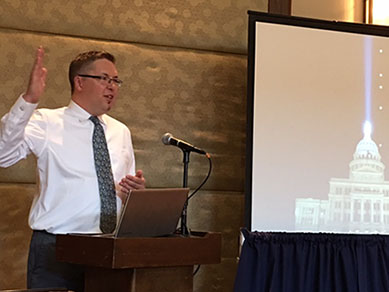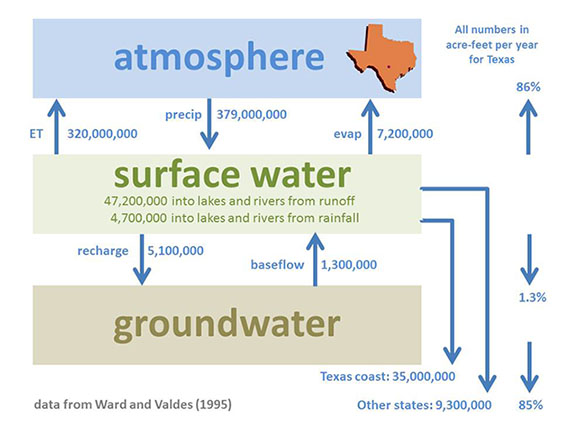Texas Water!
Oct 13

The Legislative Research Librarians Staff Section of the National Conference of State Legislatures recently welcomed Dr. Robert Mace of the Texas Water Development Board for a presentation at a professional development seminar in Austin. Dr. Mace told a fascinating and timely story of Texas water, including data, planning, and financing, to ensure water supplies for the future. He also explored the incredible diversity of climates, precipitation levels, major and minor aquifers, and river basins in Texas.
James Michener said that “Water, not oil, is the lifeblood of Texas.” Dr. Mace illustrated this by building a Texas "water budget" piece by piece, from the atmosphere to surface water to groundwater.
Interesting facts about Texas water:
- 86 percent of all rainfall in Texas is evaporated or evapotranspirated ("plant sweat") back into the atmosphere.
- Only 1.3 percent of all the rainfall and surface water runoff actually make it down into the aquifer system.
- 40 percent of all water used in Texas, whether surface water or groundwater, comes from the Ogallala Aquifer in the Panhandle.
Texas water law is a combination of our Spanish, Mexican, and Texan legal history. Legal doctrines of overland flow as private property, prior appropriation, and the rule of capture govern water ownership and supplies in the state.
Recent water innovations in Texas include:
- Direct potable reuse: In a first for the United States (and only the second place in the world), Texas has started directly reusing treated wastewater for drinking water. The Colorado River Municipal Water District in Big Spring and the city of Wichita Falls are early adopters.
- Aquifer Storage and Recovery (ASR): This process injects water back into an aquifer for later use. ASR avoids the ravages of evaporation, and has been utilized in San Antonio with transfers from the Edwards Aquifer to the Carrizo Aquifer.
- Desalination: Texas already has over 200 groundwater or surface water desalination plants inland, the largest being in El Paso. The 2012 State Water Plan includes proposals for five seawater coastal desalination plants.
- Water conservation: The average person uses 100 gallons of water per person per day, but conservation can dramatically reduce this amount. Dr. Mace suggested that by carefully studying our own water budgets, we can help save water for future Texans.
Dr. Mace's full Powerpoint presentation is available here. Photos and Powerpoint courtesy of Dr. Robert Mace, Texas Water Development Board.
Cover image from Pixabay user ronymichaud
Cover image from Pixabay user ronymichaud


